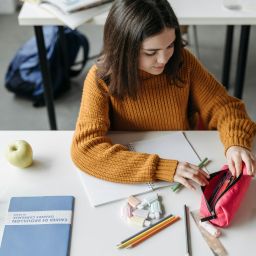
FH Summary: This post highlights the technique of “chunking” as a powerful mental First Habit that can enhance a child’s memory and contribute to their success. It explains that chunking involves breaking down complex information into smaller, more manageable chunks, capitalizing on the brain’s ability to categorize and process information. The post offers practical steps for parents to introduce and reinforce chunking as a habit in their child’s learning, emphasizing its potential to reduce overwhelm, improve comprehension, and boost memory recall. It also shares a success story of Sam, whose struggle with remembering dates transformed into a strength through the practice of chunking.
Here at First Habits, we hold a strong belief that the habits formed today define the future for ourselves and our children. And, we’re not merely talking about elementary routines such as teeth brushing or cleaning up toys, but a far broader and profound scope – mental habits and the way that our children see and process information. Among these, one that stands out is the technique of “chunking,” an empowering mental habit that can amplify your child’s memory skills, opening new doors to learning and success. Are you intrigued to unlock this potential in your child? Come, let’s explore together.
What’s Chunking Anyway?
In the context of psychology and cognitive science, chunking is a proven method to enhance memory. The technique involves breaking down complex information into bite-sized chunks that are easier for the brain to process. It capitalizes on the natural capacity of our brains to categorize and systemize information, thereby boosting memory recall.
Let’s break it down with a simple illustration. Try to memorize this string of numbers: “1-9-8-6-2-0-2-3.” Quite challenging, isn’t it? Now, what if we chunk it down into “1986-2023”? Suddenly, it feels more manageable, doesn’t it? Now 1986 and 2023 are familiar because they are easily recallable years, but did you know that there’s a reason that phone numbers less the area code are seven digits? It’s because seven digits is more or less the maximum amount of digits that humans can store in their brains for a short period of time. Let’s take another example “9-5-3-6-1-4-3-3.” That number might be a little difficult to store in your brain for a long period of time, but using the techniques that we’ll teach you in the balance of this post, you should be able to chunk those numbers into something much more manageable and memorable.
Our brains, while remarkable, have a limit to the information they can handle at a given moment. Chunking reduces this cognitive load, thus increasing the amount of data we can remember.1,2 Considering its power, imagine the profound implications for your child’s journey of learning and development.
Using Chunking to Supercharge Your Child’s Memory: An Essential ‘First Habit’
Investing in your kids holds paramount importance. And, we’re not just talking about financial investments; we’re referring to the investment of your time, effort, and resources in nurturing the right habits in them. Chunking is a technique that can significantly improve your child’s learning process, making it less overwhelming and more efficient. If your child understands chunking a little early than some of their grade-level peers then they will be more likely to succeed in their early academic efforts which will have them more likely to start down an upward spiral path.
Applying Chunking to Your Child’s Learning
Children are naturally curious beings. Their minds, ripe for learning, are eager to absorb information from the world around them. But when faced with large amounts of data, they can easily become overwhelmed. Think about a time when you tried to memorize too many things and ended up not remembering any of them. In the above example, if someone read out to you a string of 10 digits with one digit being called out every two seconds, you might end up being so focused on the 7th digit that you end up forgetting the first and second. This is all too common for us in our lives. But if you have a powerful First Habit of chunking then you can effectively take the first few digits and lock them in your memory before the next digits roll in. Chunking is not just a strategy to memorize numbers, although it can be effective at that. Any list that’s more than three to four items can effectively be chunked. All you need to do is make sure that the relationships between the items is understood and the listing of the items is as broken down into groups as possible.
So this is where chunking comes in as an effective strategy. Let’s walk through how you can help your child harness the power of chunking:
Start Small: Kick off with simple tasks that involve categorizing items into groups. For instance, you could ask your child to sort their toys based on color, type, or size. This activity serves as a practical introduction to chunking, as it helps children understand how grouping similar items together can simplify their recall later.
Scale Up Gradually: Once your child is comfortable with the basic idea of grouping, you can introduce chunking in a more academic context. For example, you could teach them to break down complex words into syllables or group historical events by era. This step will make them more familiar with the application of chunking in their daily learning.
Reinforce Through Repetition: Just like any habit, chunking becomes more ingrained through repetition. Make chunking a regular part of their study routine. Over time, your child will instinctively use this technique when encountering new information, enhancing their ability to comprehend and remember it.
In the words of Dr. George A. Miller, a prominent figure in cognitive psychology and a staunch advocate of the chunking theory, “The magic number seven, plus or minus two: Some limits on our capacity for processing information.” By equipping your child with the technique of chunking, you’re effectively pushing these boundaries, enhancing their capacity to absorb and retain knowledge.
The chunking technique functions because it allows you to access the visual-spatial part of your working memory. Through repetition and by building this habit, you will also be able to move new information from your working memory to your unconscious memory that will make recalling the information feel natural. Using the chunking technique can also help you:
- Reduce stress
- Increase confidence
- Recall information faster
- Retain information longer
- Improve your ability to identify correlations
Of course, chunking is unique to every individual. What might seem important about one list of numbers to me might be totally useless to another person. This is all just based on our experiences and it’s important to let your children understand that they are going to come up with totally different manners of chunking that anyone else who is looking at those numbers.
So let’s go back and look at the following string of numbers from earlier in the post: 9-5-3-5-1-4-3-3. Pretty random seeming right? But for me I would first look at the 95, which reminds me working 9 to 5, the Dolly Parton song or potentially just the standard workday. Then 3-5 and I might think of how from 3 to 5 is the usual lull in the workday where you’re tired and just want to get out of there. 14 to me most reminds me of the 14th century and that time period and then 33 is the number that hall of fame basketball player, Scottie Pippen, wore in his playing days. So I might see Scottie Pippen in Renaissance garb flying through the air of one of those southern Renaissance paintings. Now I feel like in books, authors will sometimes pick examples that have easily digestible meanings and oftentimes you end up saying, well that’s very nice and easy, but what about the real world? For this reason, we chose the 8-digit string of numbers totally at random. And obviously it takes a while to think through these components of the 9-5 workday, 3-5 afternoon lull and 1433 as renaissance and Scottie Pippen, etc. But with enough technique and effort, these connections will start happening as a First Habit and they can happen in an instant. This is how all the top memorizers in the world break things down.
We also focus on visualization as a key part of memorization. We learned about that in the blog post here. Scottie Pippen flying through an old-style painting is not something I’m going to forget very quickly.
The Positive Domino Effect of Good Habits
It’s essential to understand that developing good habits leads to an upward spiral in a child’s life. By teaching your child the habit of chunking, you’re setting them up for academic success, thereby fostering self-confidence and a love for learning.
Consider Sam’s story, a 9-year-old who always struggled with remembering dates for his history tests. His parents, who were avid readers of First Habits, decided to introduce him to the concept of chunking. Instead of attempting to memorize dates in isolation, Sam started grouping them into significant historical periods. This technique not only made it easier for him to remember the dates but also helped him understand the broader context of events. As a result, Sam’s struggle with dates transformed into a strength, greatly enhancing his performance in history and boosting his self-confidence. In addition, Sam was able to spend far less time to get to a level of proficiency that surpassed what he would have been able to reach otherwise. He was able to use this extra time to enjoy family activities that he would have had to miss and read some of his science fiction books that have been helping to gradually build up a steady reading habit! This story serves as a shining testament to the transformative potential of the chunking habit on a child’s learning and development.
Fostering the Habits that Pave the Way to Success
At First Habits, our mission is to provide parents with the tools they need to foster habits that contribute to their child’s success. We firmly believe that every child has a sea of untapped potential waiting to be unlocked through the right habits and effective learning strategies such as chunking.
As parents, our role goes beyond providing for our children. We are their guides, the wind beneath their wings, enabling them to soar towards their unique destinies. This isn’t about pressuring them to perform; it’s about equipping them with strategies and habits that will serve them well, today and in the future.
Let’s commit to making a positive difference in our children’s lives. Let’s set the stage for an upward spiral of learning, growth, and success. Embrace the power of chunking and witness your child’s transformation into a lifelong learner.
We invite you to delve deeper into essential habits to instill in your children and how to implement them by signing up for our weekly newsletter on the First Habits website. We’re here to accompany you on this exciting journey of raising future leaders. Because every child deserves the opportunity to learn, succeed, and flourish.
1 George A. Miller’s Research: One of the foundational studies on chunking was conducted by cognitive psychologist George A. Miller in his 1956 paper, “The Magical Number Seven, Plus or Minus Two: Some Limits on Our Capacity for Processing Information.” Miller observed that the average number of objects an individual can hold in their working memory is about seven, and that this capacity could be effectively increased through chunking.
2 Chase and Simon’s Chess Study: Another famous study illustrating the power of chunking was conducted by psychologists William G. Chase and Herbert A. Simon. They found that expert chess players could remember meaningful chess configurations significantly better than novice players or individuals who didn’t know chess. The experts were able to “chunk” the chess pieces based on their understanding of the game, allowing them to remember large amounts of information about the game board.












